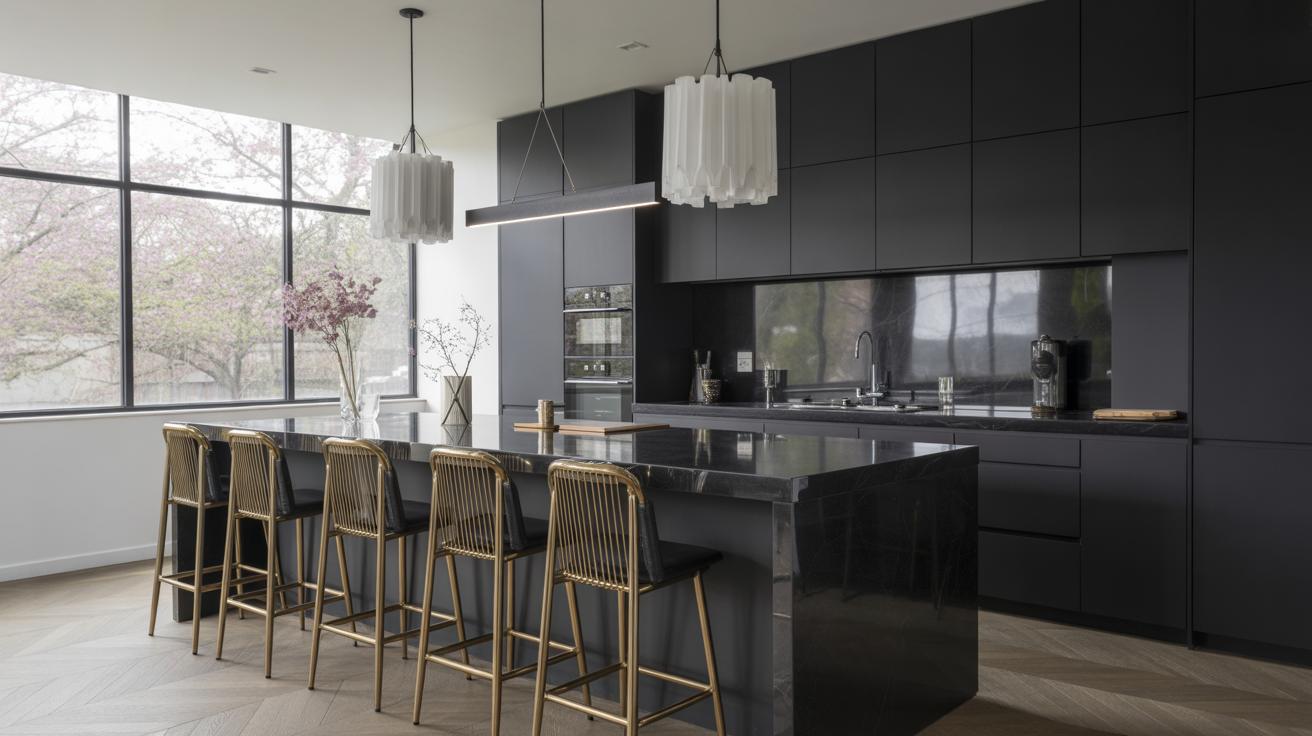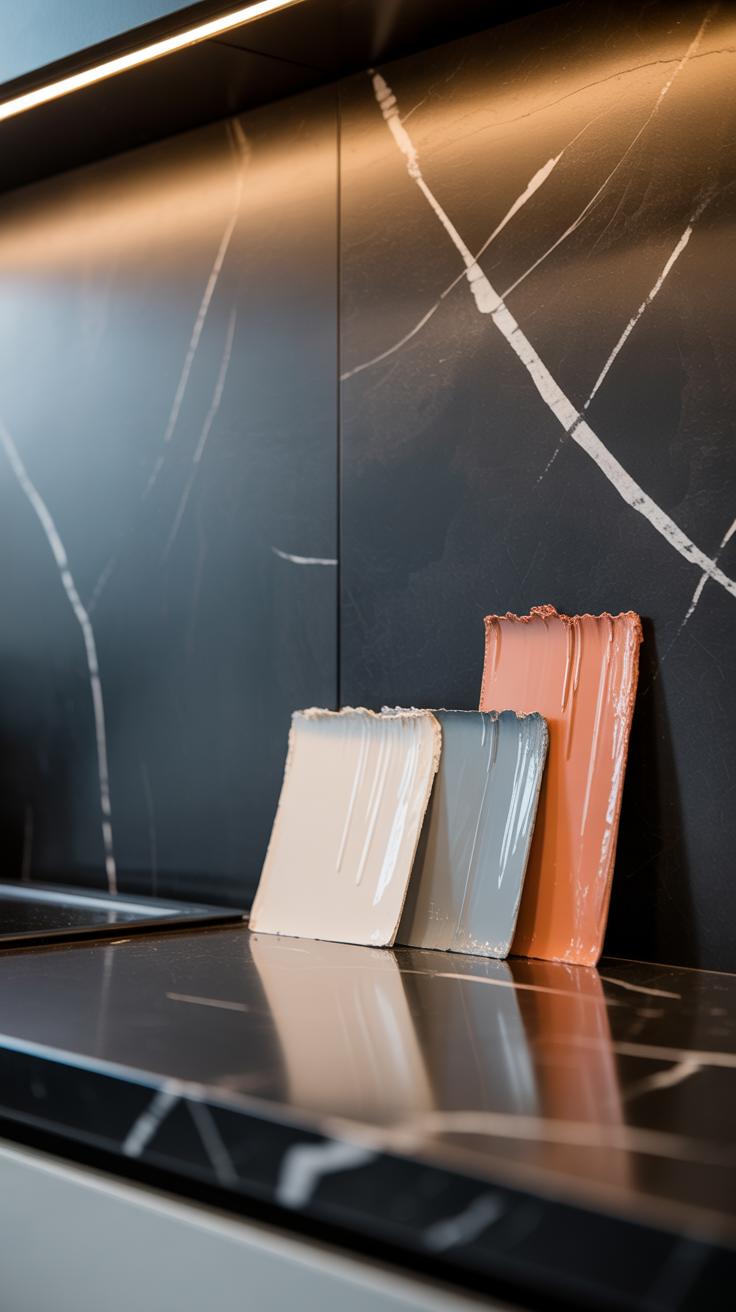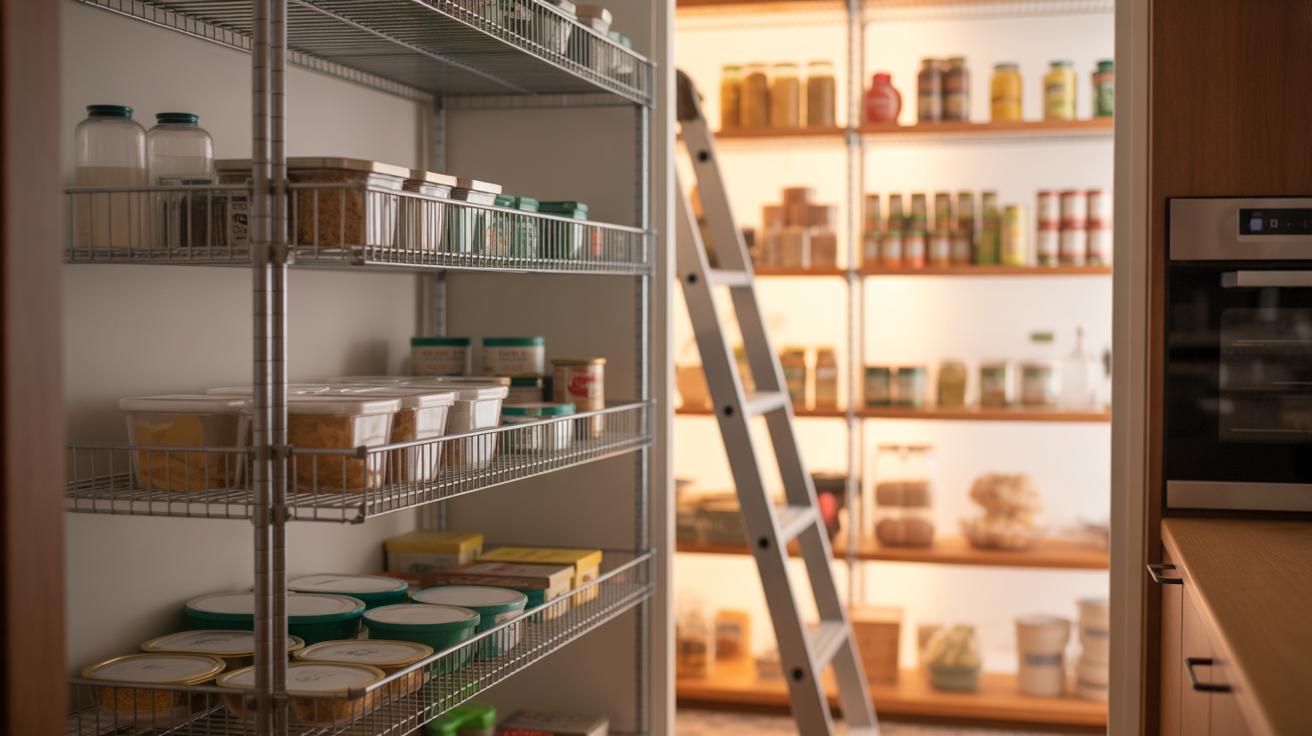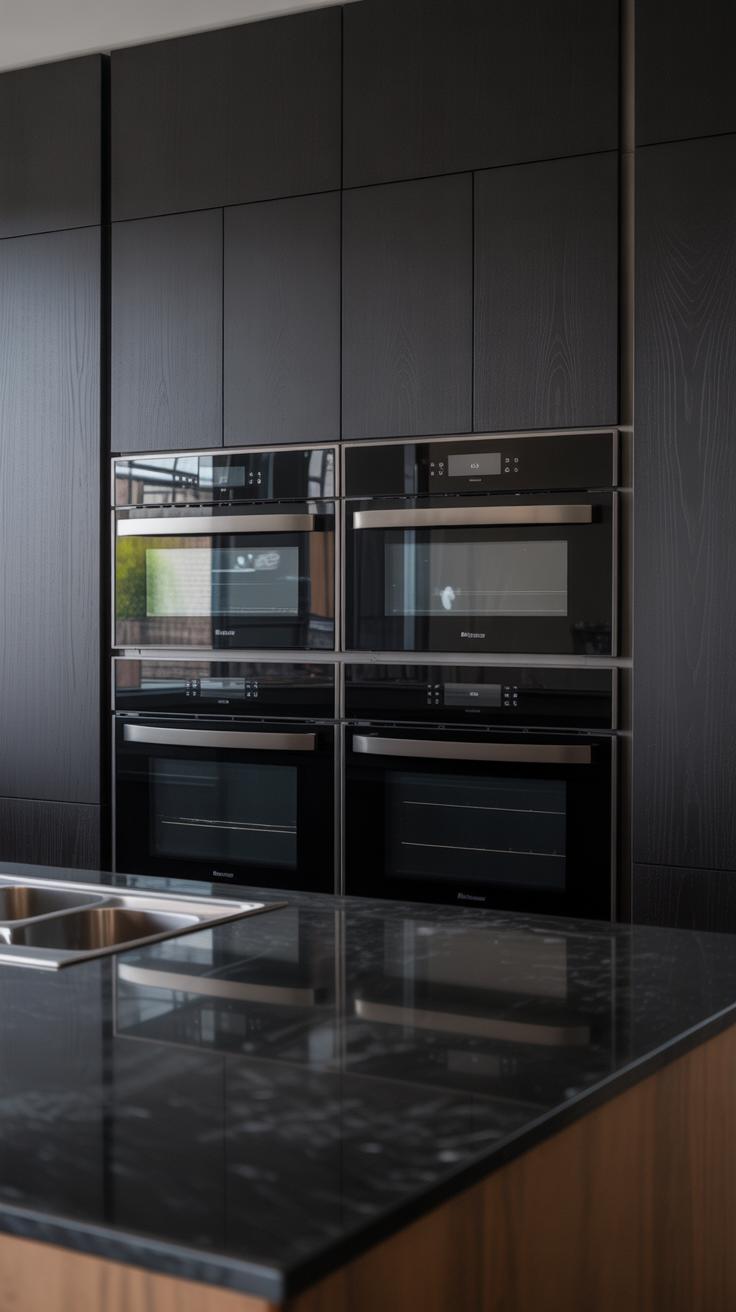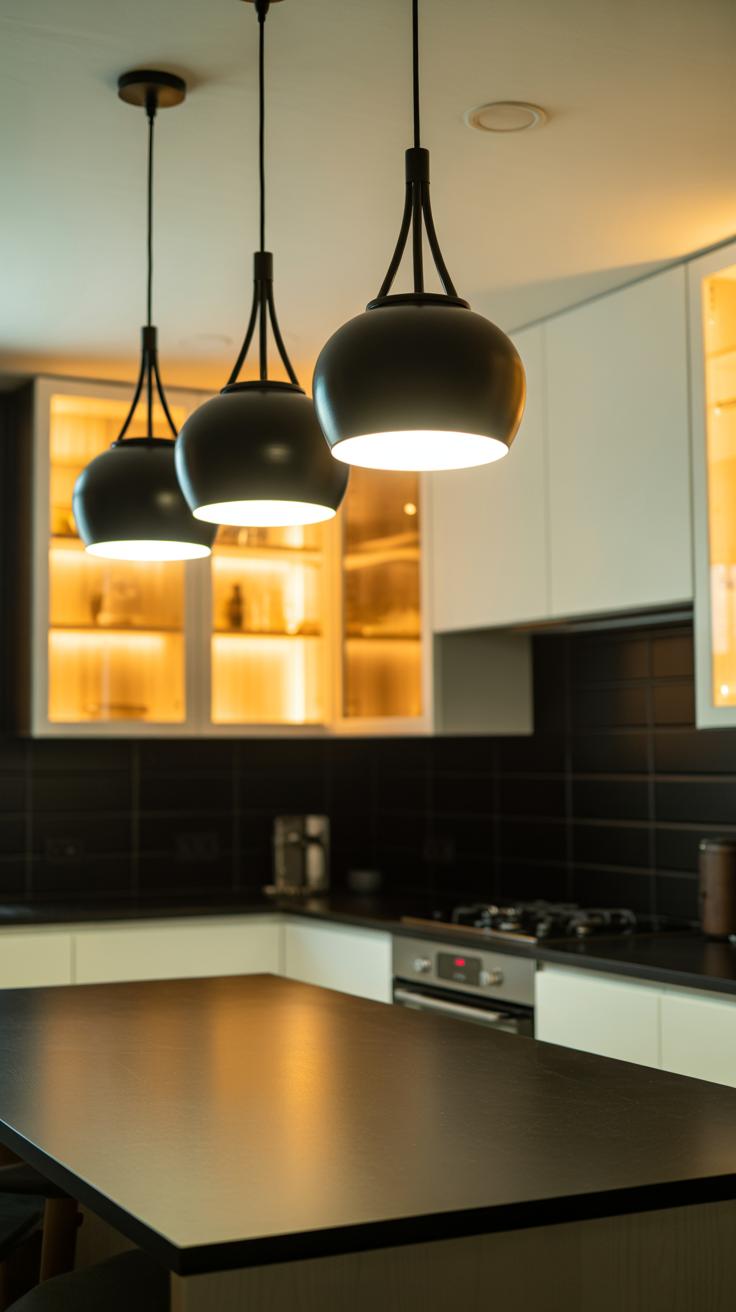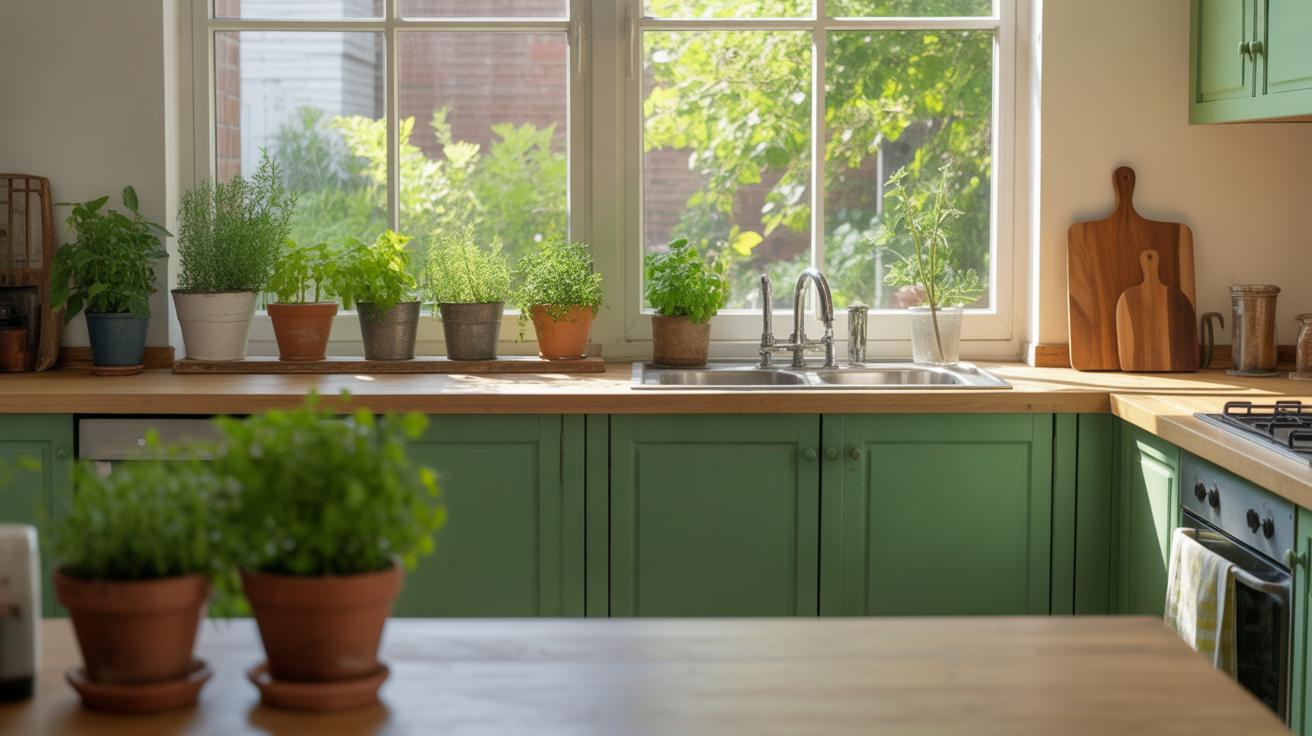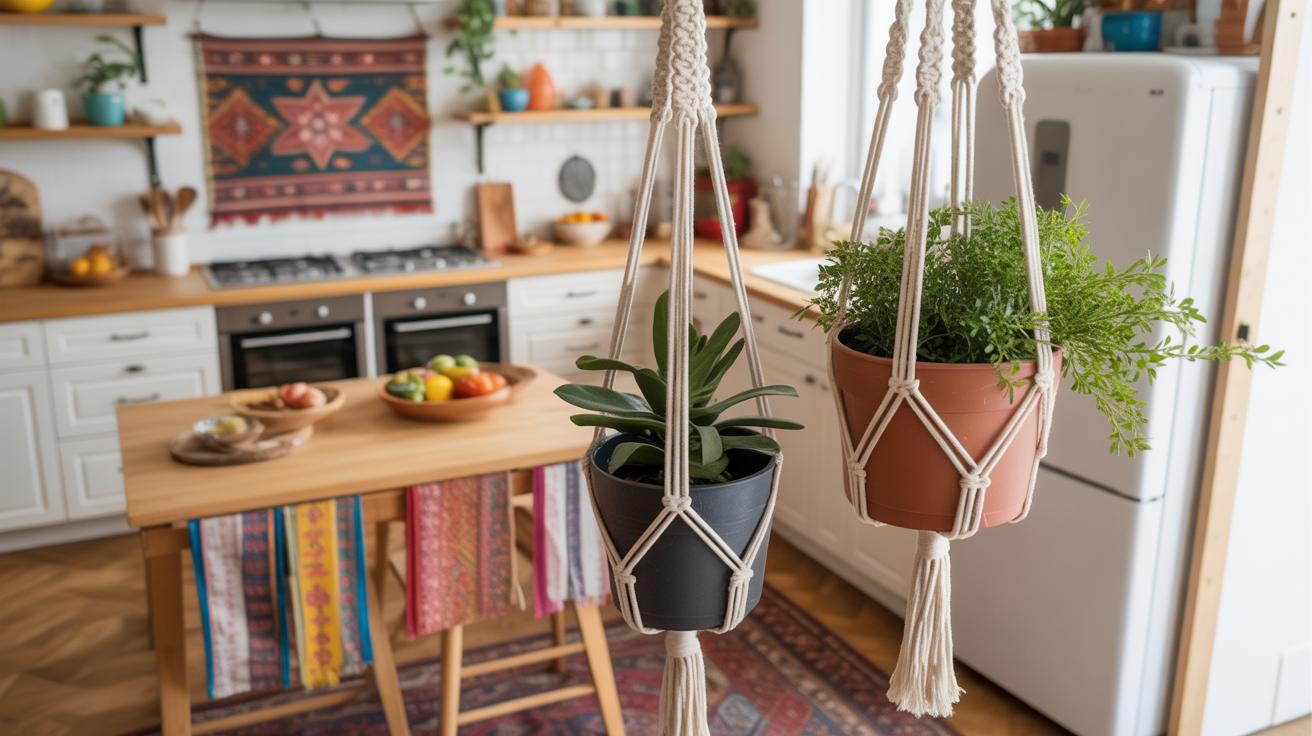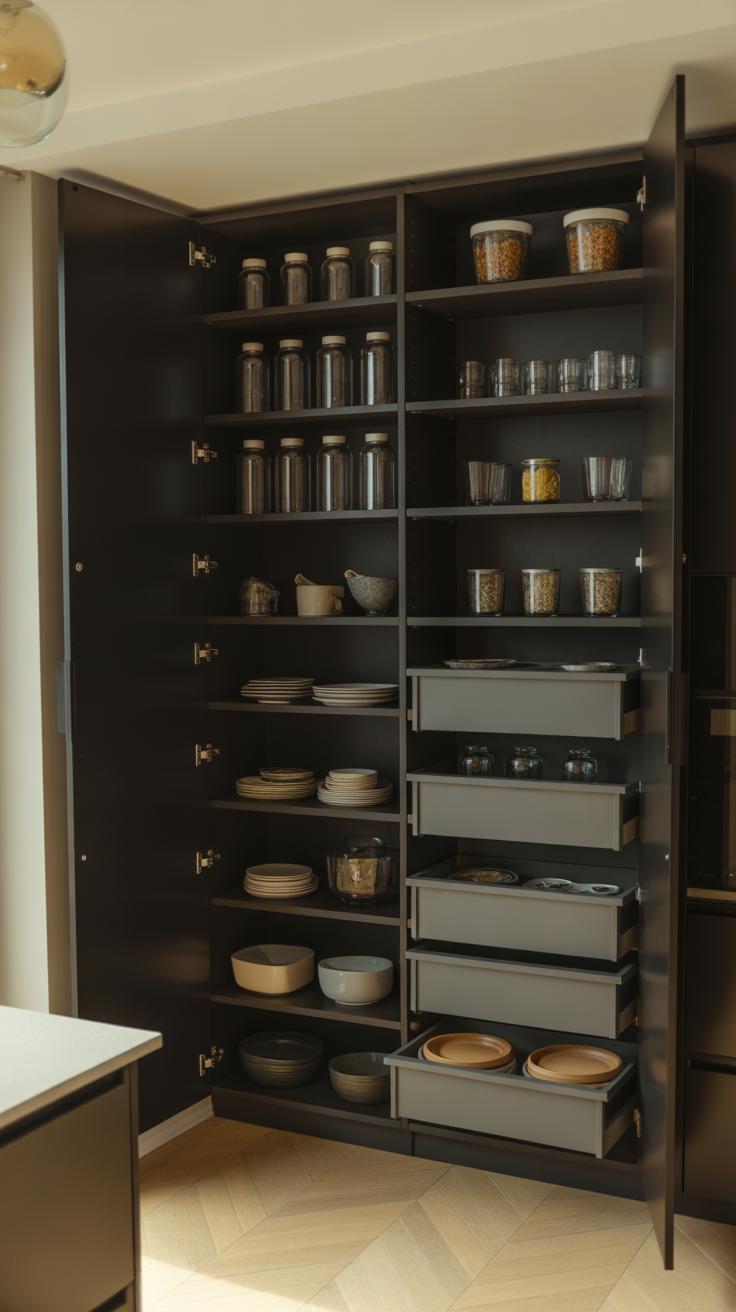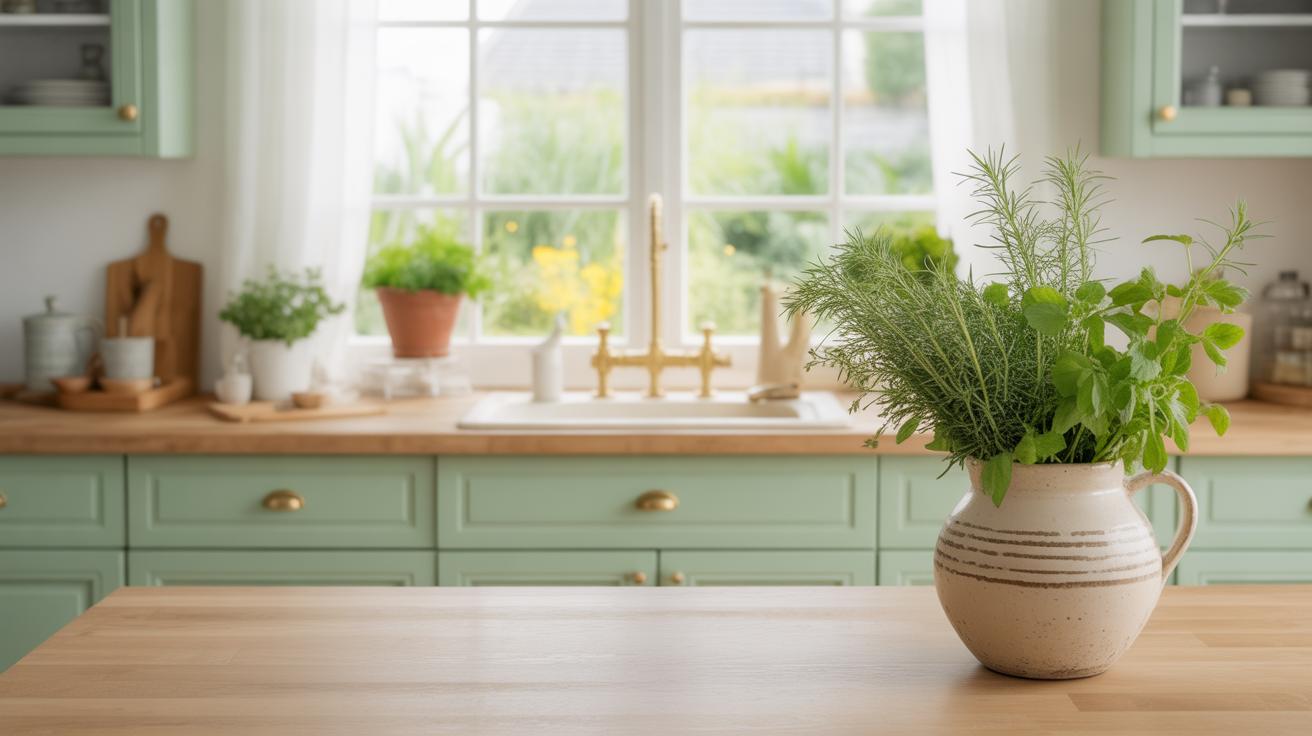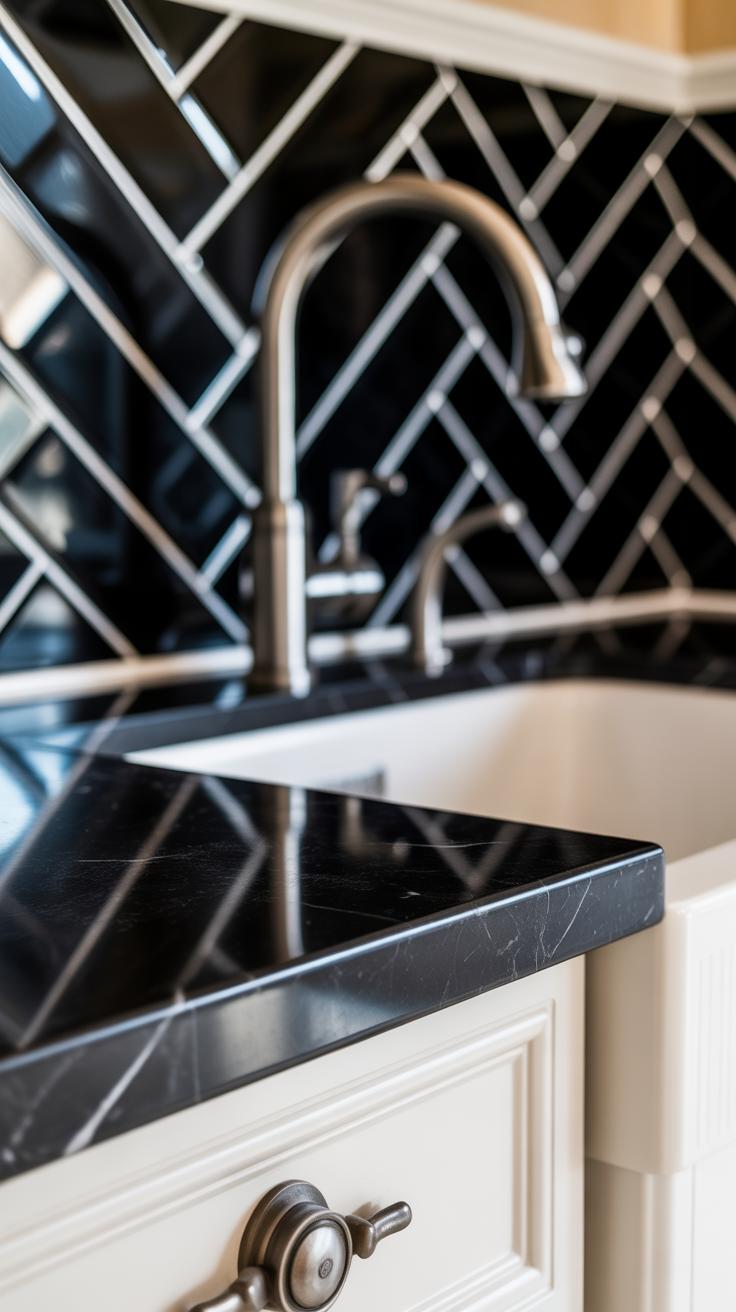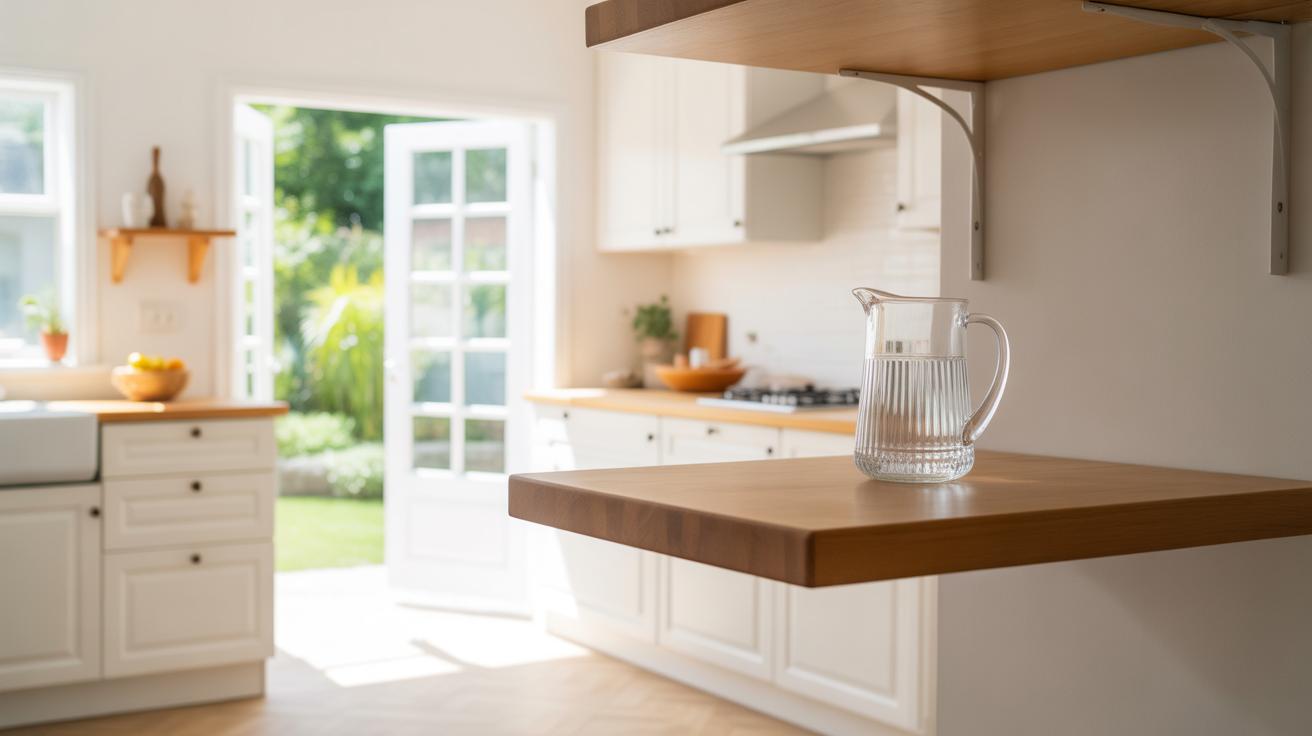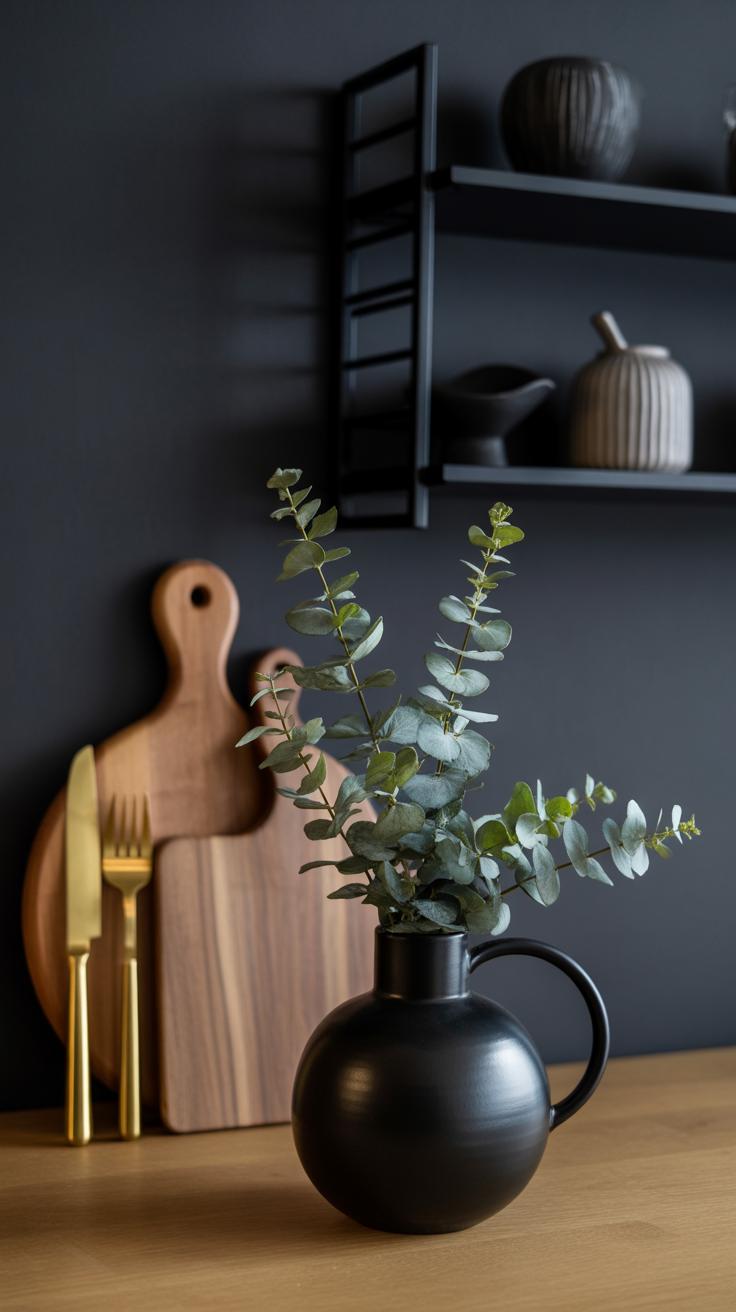Introduction
Modern black kitchens offer a unique way to bring boldness and luxury into your home. Black is a strong color that can create an elegant atmosphere while keeping the space modern and stylish. Many people hesitate to use black because they think it might make the kitchen look dark or small. Yet, with the right design choices, black kitchens can feel open, warm, and inviting.
In this article, we will explore ideas on how to design a modern black kitchen that stands out. You will learn about materials, lighting, and decoration choices that can help you make your kitchen both practical and beautiful. By the end, you will have plenty of ideas to create a kitchen space that reflects your bold taste and love for luxury.
Choosing the Right Black Shades
Black is not just black—there’s a surprising range of shades that can totally change your kitchen’s vibe. When deciding on black for your space, think about whether you want something deep and pure or a softer black with hints of gray or brown. For instance, a charcoal black might feel less severe and more approachable than an absolute jet black, which can sometimes come across as heavy or overwhelming in smaller kitchens.
Matte and glossy finishes play a big role too, and they each bring something different to the table. Matte black tends to give a smooth, almost velvety feel—less reflective, more subtle. It feels modern but not flashy, which might appeal if you’re after a relaxed, understated look. On the other hand, glossy black finishes catch the light. They reflect surroundings and add a touch of drama. Think of glossy surfaces as a way to make the kitchen feel alive, almost a bit glamorous.
If you lean towards industrial or minimalist styles, matte black often fits best. The glossy finish, meanwhile, can work well in contemporary or even luxe kitchens where every surface seems to shine. It depends on the mood you want: calm and muted, or bold and eye-catching.
Warm versus cool black tones make an impact too, and this is sometimes overlooked. A warm black might have brown or even red undertones, which can soften the space and feel inviting—this might be perfect for cozy family kitchens. Cool blacks, with bluish or gray undertones, tend to feel sharper, cleaner, even a bit more formal.
Choosing between warm and cool blacks can be tricky. Ask yourself: Do you want your kitchen to feel like a cozy haven or a crisp, modern showroom? Your choice influences everything—from cabinet colors to countertop pairings.
Mixing Materials for Texture and Depth
When working with black in your kitchen, the flatness of a single finish can get a bit… dull. Mixing materials breaks that monotony and adds real interest. Think about combining black cabinetry with wood, metal, or stone—it doesn’t just look layered, it feels layered. You might be surprised at how these contrasting textures play off one another, creating a space that invites closer inspection rather than turning you away with too much darkness.
Using Wood to Soften Black
Wood is almost the natural antidote to the boldness of black. It brings warmth and a bit of softness. Picture sleek black drawers paired with walnut shelves or a butcher block countertop. That warmth interrupts the black without lessening its impact. And if you worry wood might clash, try choosing wood tones that lean towards honey or chestnut rather than harsh, pale wood. I once saw a black kitchen with rich oak accents that felt like it was telling a story—bold but comforting.
Wood absorbs light differently. It can bring balance where black might feel too heavy. Even small touches—a wooden cutting board or open shelving—give your kitchen a tactile quality you can almost feel with your eyes.
Metallic Accents That Shine
Metals add an element of surprise. Brass, copper, or stainless steel edges catch light and introduce just enough contrast to prevent black from becoming too flat or oppressive. Consider drawer pulls, faucets, or even lighting fixtures that shine against the dark backdrop. Brass can feel lush, while stainless steel gives a cooler, modern twist. I’ve noticed how a simple brass handle can redefine a whole black cabinet—it’s subtle but transformative.
Don’t overdo it. Pick one or two metal finishes to keep things coherent. Mixing too many can confuse the eye and compete with the black. But used thoughtfully, metal accents give your kitchen a little sparkle—almost like jewelry—to complement the furniture.
Lighting Your Modern Black Kitchen
Natural Light Importance
Black kitchens can sometimes feel a bit heavy or closed in—at least that’s what many assume. Yet, with the right approach to natural light, that darkness can feel intentional, even inviting. If your kitchen has black cabinetry or walls, consider how sunlight moves through the space during the day. Windows facing south or west bring warmth, so if you have those, try to keep them as unobstructed as possible. Thin, sheer curtains or no covers at all help a lot.
Think about reflective surfaces too, like a glossy backsplash or light countertops near windows. They bounce light around and cut through the darker tones. One place I’ve noticed this really works: black cabinets paired with a crisp white marble island near a large window. It breaks up the darkness without losing the dramatic vibe.
Also, if windows are limited, adding a skylight or solar tube might seem like a hassle, but often the reward of real daylight is worth it—you’ll question why you didn’t do it earlier.
Choosing Artificial Lighting
When daylight fades, artificial lighting becomes your best friend. In black kitchens, layers of light can make a huge difference, and some options work better than others.
-
Pendant lights right over the island or breakfast nook create focal points. Glass or metal fixtures with warm bulbs add a glow rather than harshness.
-
Under-cabinet LEDs serve two purposes: they illuminate work surfaces and lift shadows. Since black absorbs so much light, this helps keep the kitchen practical without ruining the atmosphere.
-
Recessed ceiling lights offer general brightness but can sometimes feel cold. Pair them with softer sources—or dimmable switches—and you control the mood.
One detail that feels overlooked is the warmth of the bulb. Cooler, bright white lights can make the space feel clinical, which you don’t want in a kitchen meant for comfort and style. Warm whites, around 2700K to 3000K, usually feel more natural. That said, you might like a bit of contrast—maybe a cooler pendant to balance things out? It’s all about what feels right to you.
Designing Layouts for Black Kitchens
When you think about modern black kitchens, the layout plays a big role in keeping the space feeling open and inviting, rather than cramped or dark. Open plan layouts work surprisingly well here—they let the black elements breathe and create a sense of continuity. When your kitchen flows directly into a dining or living area, those black cabinets and countertops don’t overwhelm but become part of a larger, connected space.
For flow, consider placing the main work zones—the stove, sink, and fridge—along a triangle path. This classic setup still fits open plans nicely and makes your kitchen practical, not just stylish. You might find that having the island act as a subtle divider also helps preserve openness while still defining the kitchen boundary.
Open Plan Kitchen Layouts
Open plan layouts give black kitchens space to shine. They prevent dark colors from making the room feel boxed in. It also allows natural light from adjacent rooms to spill into the kitchen, softening black surfaces. Think about arranging seating around the island or a peninsula, so it encourages interaction while cooking or entertaining. You don’t want the kitchen to feel too isolated or, ironically, too stark.
One tip that worked for me was placing darker elements against lighter flooring and walls beyond the kitchen. This contrast expands the visual field and keeps the focus balanced, not overwhelming.
Using Island Counters
Islands in black kitchens are more than just extra workspace. They’re central features you can style boldly or keep minimalist depending on your taste. Black islands with clean lines and matte finishes can feel surprisingly warm when paired with wood or metal accents.
Functionally, islands offer great storage and seating options, which is valuable when you want an uncluttered look elsewhere. You could try a black island with a lighter countertop to break the monotony. Or, perhaps, choose a glossy finish for a bit more drama. It’s all about finding the balance between practical needs and aesthetic impact. Would a black island light up your cooking routine—or just add more shadows? That’s something to think about when planning your space.
Black Kitchen Cabinets and Storage Solutions
Flat Panel Cabinets
Flat panel black cabinets give your kitchen a streamlined and modern feel that’s hard to ignore. They’re smooth, without the fuss of intricate molding or raised panels, which keeps everything visually neat. The simplicity of these cabinets often creates a sense of spaciousness, even in smaller kitchens, because the eye isn’t distracted by extra detail. You might find that their minimalist style pairs well with a variety of hardware finishes—brass handles feel luxurious, while matte black pulls keep things subtle. I’ve noticed that some people hesitate with black cabinets, worrying they might look too dark or overwhelming, but flat panels can balance that by reflecting light just enough to avoid a heavy vibe.
Also, the flat surfaces make cleaning easier, which is something you probably appreciate in a kitchen. Smudges show up, sure, but the smooth finish wipes down without the edges and grooves you get in other cabinet types.
Hidden and Smart Storage
Keeping a black kitchen tidy can be tricky; dark surfaces show clutter more clearly. That’s why clever storage is a game changer. Pull-out shelves transform deep cabinets, letting you glimpse everything tucked inside without rooting around. It makes cooking less frustrating—you don’t have to empty a whole cabinet just to find a single spice jar. Some kitchens even use hidden compartments, like toe-kick drawers beneath lower cabinets or concealed bins behind cabinet fronts. These little surprises keep your counters clear and maintain black kitchens’ sleek, sharp appeal.
Have you considered corner drawers or vertical dividers for baking sheets? They can turn awkward spaces into practical places. A black kitchen often evokes boldness, but neatness must follow. Smart storage solutions make that a bit easier, though you might find yourself experimenting with setups until it fits your routine. It’s a bit like figuring out a puzzle—one piece might fit well but then another needs adjustment. Still, the payoff is worth it: a clean, organized kitchen that looks as good as it works.
Backsplash and Countertop Choices
Choosing the right backsplash and countertop is a crucial step when working with black kitchen elements. If you lean toward lighter backsplashes, white tiles are a classic choice that creates striking contrast. They can brighten up the space, making black cabinets feel less heavy or overpowering. For example, simple subway tiles or matte white finishes can balance the darkness while keeping things clean and modern. Sometimes, mixing subtle textures within white backsplashes adds dimension without cluttering the design.
On the other hand, stone countertops like marble or quartz bring a different kind of luxury to black kitchens. Their natural veining or patterns create visual interest that complements deep cabinetry. A white marble with gray veins, for instance, pairs well with black tones but avoids making the space feel too cold. Quartz offers durable options in soft light shades, subtly elevating the overall look. Yet, there’s something about stone that makes the space feel… tangible, almost inviting despite the stark color scheme.
When picking materials, consider:
- Does the backsplash lighten or deepen the mood?
- Will the countertop’s texture catch the eye without clashing?
- How will these surfaces wear over time in your day-to-day use?
In my experience, combining a crisp white backsplash with smooth marble countertops works well, but it’s not the only way. You might prefer softer contrast or something bolder—there’s room to experiment. The key is choosing surfaces that either balance or enhance the black features without overwhelming your kitchen’s vibe.
Decor and Accessories in Black Kitchens
Decorating a black kitchen calls for a careful balance. Too much darkness can feel heavy, but a few well-chosen items can lift the mood without losing that sleek, modern edge. Furniture is where you can experiment — a matte black kitchen might benefit from wooden chairs or stools with warm tones to soften the look. Metal finishes, like brass or brushed nickel, also add a subtle contrast and bring a bit of shine where it matters.
Plants seem almost necessary in a black kitchen. Their green hue breaks up monotony and injects life. A few potted herbs on the windowsill or a larger plant in a corner can change the whole atmosphere. Oddly, sometimes a kitchen can feel oddly sterile without that natural touch. You might hesitate to try plants because of light concerns, but many varieties thrive well on indirect kitchen light.
When it comes to accessories, think about materials and textures. Bar stools with leather cushions or woven seats can add comfort and a tactile layer. A rug can offer subtle color and warmth; it doesn’t need to be loud, perhaps a muted pattern in earth tones. For utensil holders or containers, glass, wood, or ceramics work nicely to offset black and avoid too stark a feel. These choices help the space from feeling too monochrome or cold.
Figuring out what makes your black kitchen feel inviting isn’t always straightforward. Sometimes less is more, but other times, a little splash of color or texture goes a long way. Do you want your kitchen to feel more like a calm retreat or a bold statement? Your choice of decor influences that, maybe more than you realize.
Maintaining Your Modern Black Kitchen
Keeping a modern black kitchen looking fresh can feel tricky at times. Black surfaces show dust, smudges, and fingerprints more easily than lighter colors, so regular care is necessary to avoid that dull or streaky look. Still, with some straightforward habits, your kitchen can maintain its bold charm.
Cleaning Black Cabinets
When cleaning black cabinetry, you’ll want to avoid harsh cleaners that leave streaks or dull the finish. Try these steps:
- Use a soft microfiber cloth dampened with warm water mixed with a mild dish soap. Wring the cloth well to avoid excess moisture.
- Wipe gently in the direction of the grain if your cabinets have one, rather than scrubbing back and forth.
- For tough spots, a vinegar and water solution can help, but test on a small, hidden area first.
- Dry immediately with a clean, dry cloth to prevent water marks or streaks.
It might be tempting to hop on the cleaning bandwagon and overdo it, but sometimes less is more. Over-cleaning can dull even matte finishes. I’ve learned that a light daily wipe down prevents buildup and saves scrubbing later.
Keeping Counters Spotless
Black countertops are stunning but can reveal every crumb and drip. Protecting them from stains and scratches is key to their longevity. Here are a few ideas that I find useful:
- Wipe spills immediately—especially acidic substances like lemon juice or wine—as they can etch some surfaces.
- Use cutting boards and trivets to prevent knife marks and heat damage.
- Clean with a soft cloth and a gentle cleaner made for your countertop material. Avoid abrasive scrubbers.
- If your counters are polished, buff them occasionally with a dry cloth to restore shine.
It’s funny how simple awareness can keep counters looking nearly new, but sometimes I catch myself letting small spills sit longer than I should. It happens. What’s your routine for keeping counters clean without endless effort?
Conclusions
Choosing black for your kitchen is a way to make a design statement that mixes boldness with luxury. Modern black kitchens are not just about the color; they are about how you combine materials, lighting, and space to bring your vision to life. You can create a kitchen that feels both stylish and functional.
As you plan your modern black kitchen, think carefully about the details. Use lighting to brighten the space. Mix different materials for texture. Add personal touches that make the space yours. Your kitchen can be a place where beauty and practicality meet.

